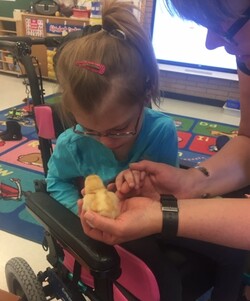Using Senses Effectively

Developing sensory awareness is vital for a student with deafblindness because they have limited or no access to visual and/or auditory information. Students need to learn how to use their other senses effectively so that they can gather important, reliable information that helps them understand their world around them and where they are in the world (Martinez, 2021).
Using our senses and movement together for exploration is important. The senses provide a lot of useful information that lets you know where you are and know when you've arrived at your destination. Helping students with deafblindness tune into sensory information around them helps them learn. As EA-Intervenors, part of your job is drawing your student's attention to the sensory information available so that they can interpret the information (Martinez, 2021).
Sensory rich environments provide access to a large variety of experiences that helps with cognitive development (Smith, 2014). Suggestions for developing sensory awareness (Nicholas et al., 2018; Smith, 2014):
- Provide opportunities for tactile exploration
- E.g., use real objects, such as a real flower, not a paper one
- With your student, focus on the physical dimensions of an object
- E.g., explore edges, flat surfaces, texture, curves, temperature, weight, smell, sound, salient visual features, etc.
- With your student, focus on an object of interest in the immediate vicinity
- E.g., talk about the object - why is it there, what does it do, who uses it, is it always there, can it be found elsewhere, can you find it again somewhere else. Explore the physical dimensions of the object (see above)
- Draw your student's attention to environmental information
- E.g., when you are on your way to the gym with your student, what landmarks do you pass? What tactile information does your student gather from landmarks? What does your student see, hear, smell, feel?
- E.g., when you and your student pass by a room and there's the scent of popcorn in the air, talk about it. Where are you in the school? Why do we smell popcorn? When do we smell popcorn at school? How can we get a bag of popcorn?
- E.g., explore the room cue outside the classroom and other important locations (colour, shape, size, texture)
These are just a few ideas. Your O&M specialist, TSVI, and POPDB Teacher can help you learn how to provide students with materials and experiences to enhance sensory experiences.
Martinez, C. (2021). Orientation and mobility training: The way to go. Texas Deafblind Project. https://txdeafblindproject.org/orientation-and-mobility/orientation-and-mobility-training-the-way-to-go/
Nicholas, J.T., Johannessen, A.M., & van Nunen, T. (2018). A checklist of learning strategies that support tactile working memory. Nordic Welfare Centre.
Smith, M. (2014). Sensory efficiency. In C.B. Allman & S. Lewis (Eds.), ECC essentials: Teaching the expanded core curriculum to students with visual impairments, (pp. 117-171), AFB Press.